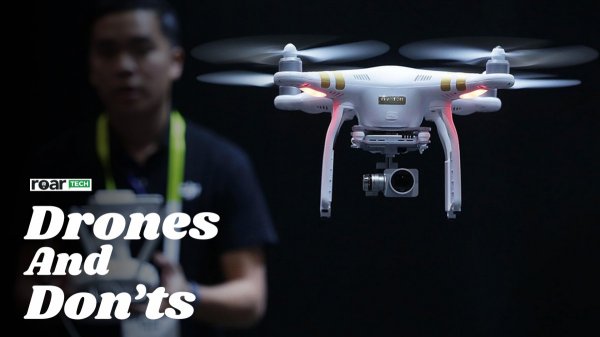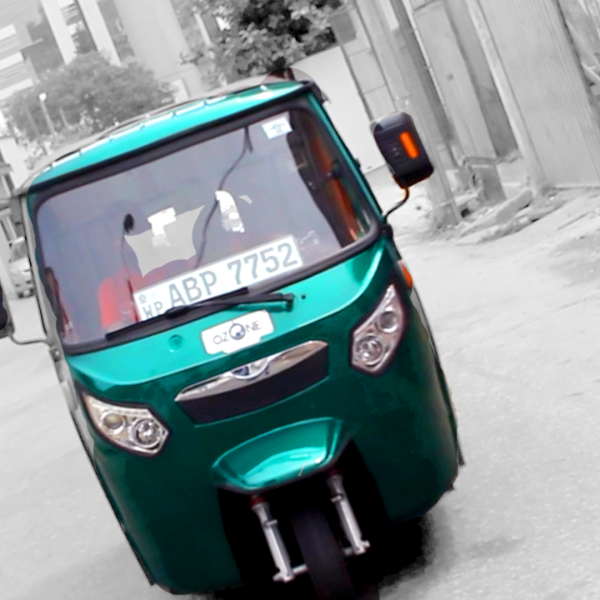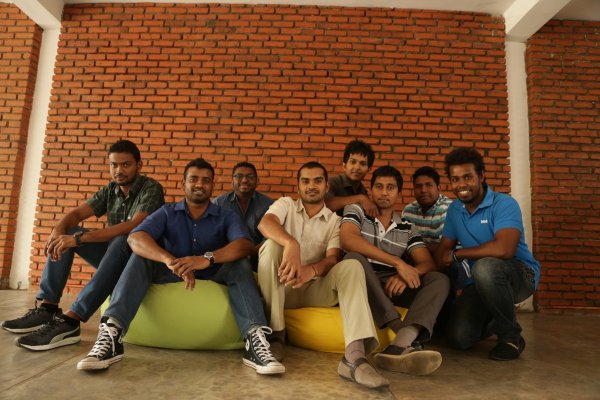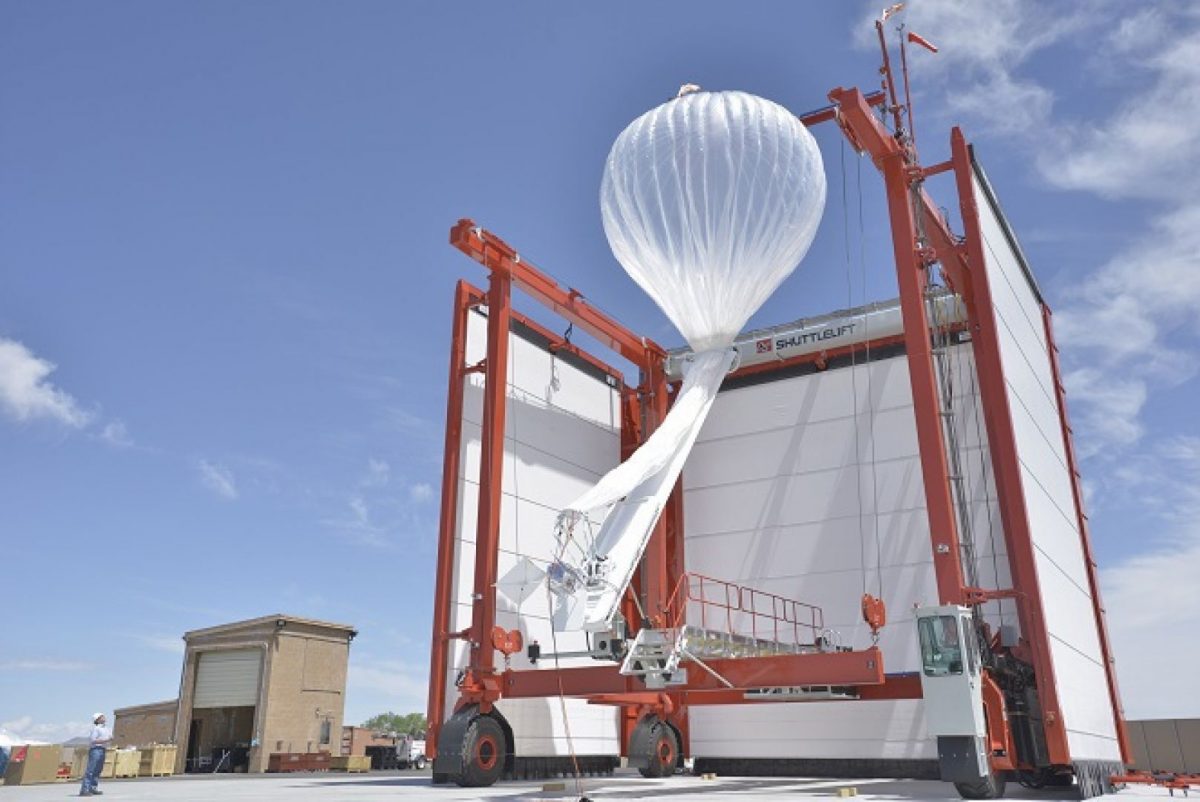
A few months ago, Google’s Project Loon was the talk of the town. Excitement peaked when it was reported that the first balloon had entered Sri Lankan airspace to begin feasibility tests. Although the hype appeared to die down after a while, the fact of the matter is: Google Loon is finally here.
A Little Background
Project Loon is one of Google’s ambitious plans to make internet more available and affordable around the world, by using balloons as the primary infrastructure. Google started testing the service in 2013. Last year, word on the international platform was that Sri Lanka had become the first country to partner with Google to bring islandwide internet access with the help of Project Loon. [You can check out the comprehensive breakdown we published at the time over here.]
Since then, a lot has happened.
The initial Memorandum of Understanding between the Sri Lankan Government and Google was signed last July, and the tests were supposed to start before the end of last year. But there were some delays. Nevertheless, we have finally seen some actual progress in the mission. The question is, where do we go from here?
Testing… And More Testing
Sri Lanka is not the first country to carry out the Loon testing. Tests have been previously carried out in New Zealand, Brazil and California. Indonesia will soon join the list of nations to carry out the tests. India, too, has expressed interest in carrying out tests in their territory, to asses the possibility of launching the service. According to sources from the Information and Communication Technology Agency of Sri Lanka (ICTA), a total of three balloons were supposed to be used in the preliminary testing. One of the balloons launched from South America was the first to enter our airspace. Representatives from Google have also visited Sri Lanka to start testing on technical aspects, such as flight controls and spectrum efficiency.
How Google Loon Works

Structure of the Google Loon and how it works
Currently, a number of balloons are flying in the stratosphere, well above a height of 20 km, much higher than the altitude at which commercials flights are operated. They are controlled by Google’s “Loon Centre” ‒ a mission controlled centre based on the ground. The altitude of the balloon is controlled by the wind pattern of the area in which it is floating. Ground staff can control the balloons’ locations by changing their altitude to catch wind currents. To quote Astro Teller, the Chief of Google X, which comes under Alphabet (Google’s parent company, of which the Google Loon Project is also part of), “The idea is to have enough balloons, so as one floats out of your area, there’s another one ready to float into place, handing off the Internet connection just like your phone hands off to different cell towers as you drive down the freeway.”
As for the makeup of the balloons used in the Google Loon project, there are two balloon components with different content. The inner balloon has natural air, whereas the outer balloon stores helium. There is a small, fan-like attachment in the inner balloon that fills the balloon with air. Whenever Google wants to bring the balloon down (to change direction or to land it) a command will be sent to the in-built fan to fill the inner balloon with more air, and the gradual increase in weight will cause the balloon to float down. Whenever they want to increase the altitude of the balloon, they simply release some air from the inner balloon.
How A Google Loon Balloon Is Landed In Sri Lanka
In Sri Lanka, the landing procedure involves various stakeholders, including air traffic controllers, the Civil Aviation Ministry, and Air Defence Monitors from the Defence Ministry. The air traffic controller is informed five hours prior to any landings. He then designates a time frame and a particular area with the minimum air traffic, to conduct the landing. In Sri Lanka, a village called Pupuressa in the Central Province was used to land the first balloon, which was known as HBAL178. Descent takes around an hour. Once the confirmation is received, the Loon Command Centre gives the command for ‘one of the two built-in blades’ on the balloon to cut the outer balloon and release helium ‒ and once the helium is out, the balloon starts to descend.
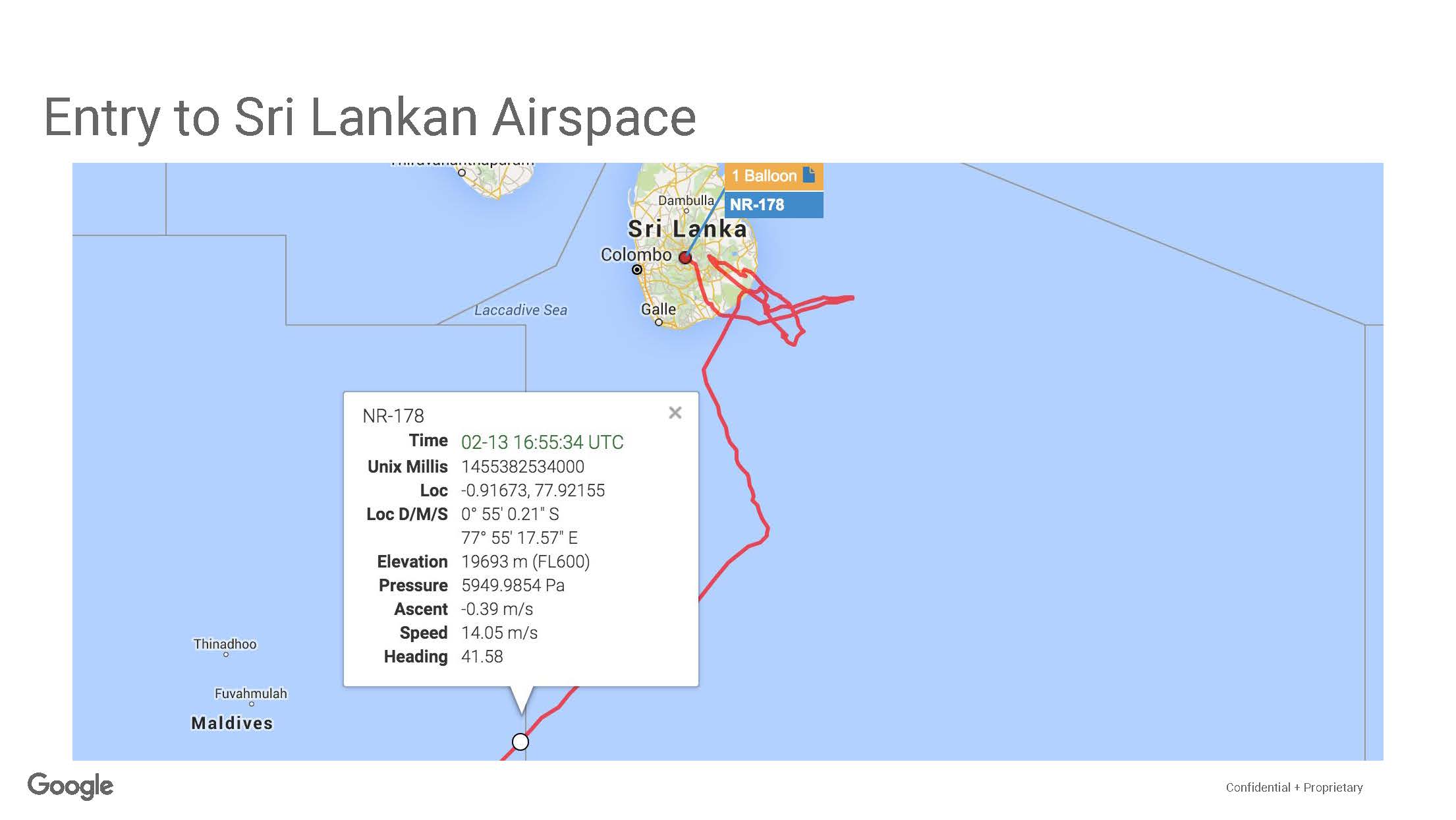
The path showing the entry of the first Google Loon into Sri Lankan airspace. Image Courtesy: ICTA
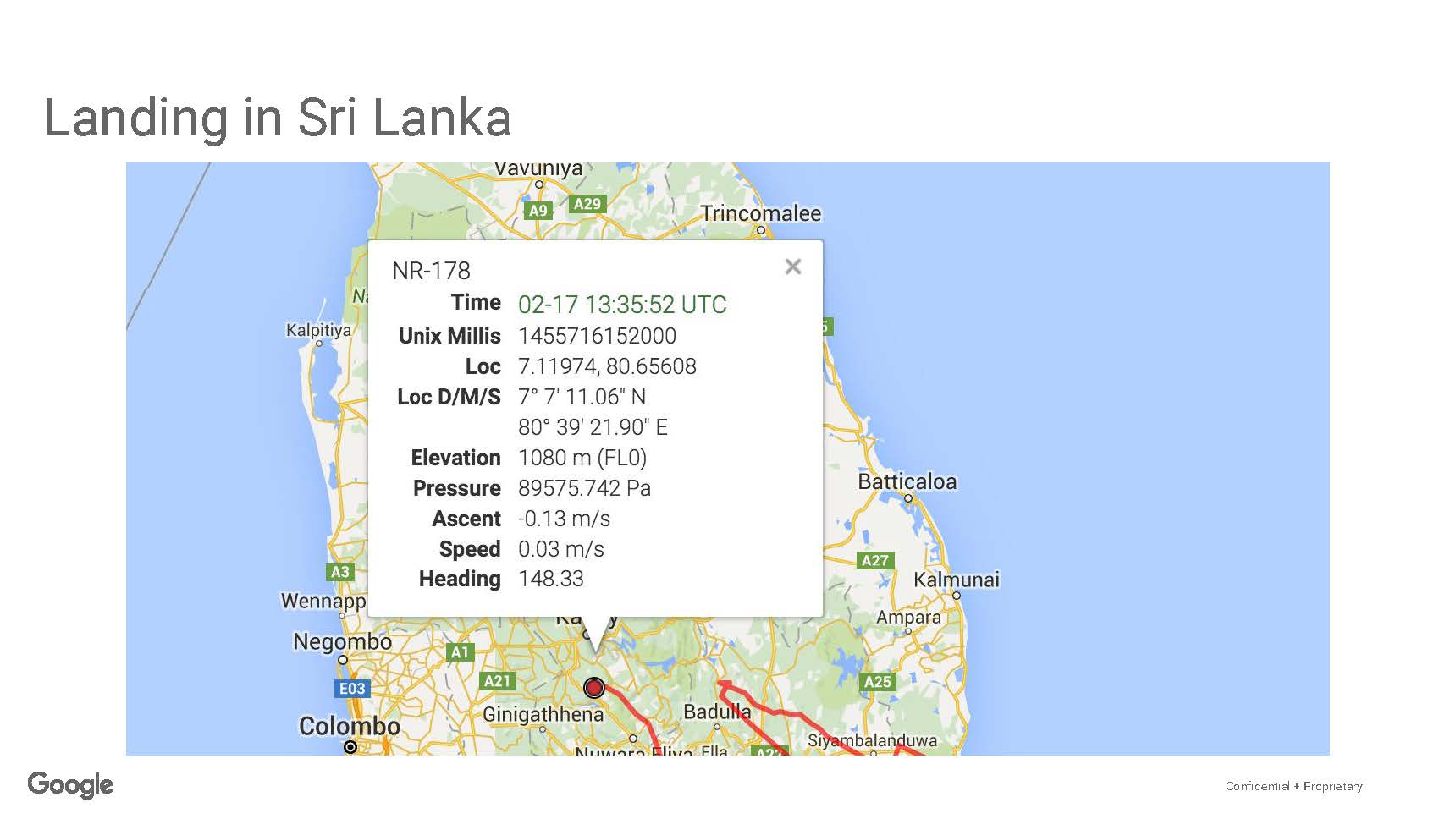
The landing location of the first Google Loon in Sri Lanka. Image Courtesy: ICTA
Frequency Testing
According to ICTA sources, once the testing with the balloons is completed, the next phase will be to test the network frequencies which will be deployed for the service. Initially, a 10 MHz spectrum will be used to test the service, and later it will be ‘leased’ out for the purpose of Google Loon internet. Essentially, Google or any other entity will not be sold the spectrum. Google will be required to work with existing service providers to share the frequencies.
Establishing The Local Venture
The next step will be to establish the joint venture linking all parties involved in the project. This body will take the project forward. As we all know, the Loon Project will require spectrums ‒ the radio frequencies that carry the wireless communication signals from one location to another ‒ to maintain the network. And the Sri Lankan Government, instead of selling any spectrum, will be leasing the spectrum to Google, and Social Capital, headed by Sri Lankan born entrepreneur Chamath Palihapitiya. Chamath’s firm has been the driving force to bring the project to Sri Lanka. Chamath has been in Sri Lanka a few times during the past couple of months, and he has also set up an ambitious new company called Rama, which will be the entity that partner directly with the Sri Lankan Government in leasing the spectrum. In the long run, Rama seeks to be a fully fledged carrier network in the United States.
Another player in the scene will be a startup called LotusFlare ‒ founded by a group of former Facebook employees, and for whom Chamath´s Social Capital is a funding partner. Chamath is also a member of the startup’s board. LotusFlare aims to provide a cloud based platform that will link local operators with the companies that provide access to technologies. In other words, they will provide the software that will act as the middleman between Google’s Loon and Sri Lanka’s local networks. They have also been rolling out tools directly to the consumers to track their data usage.
According to ICTA, the Sri Lankan Government will not be investing any money in the venture. Instead, they will hold a 25% share of the joint venture, once it is established under the BoI. Additionally, another 10% of the company shares will be offered to all the mobile network partners. All five mobile networks in the country have been invited to join the venture. The telecommunication service provider will have to invest in the infrastructure, but it will be much cheaper than the traditional infrastructure currently being used.
We also learn that the long time plan of Rama Corp. is to invest in a type of ´microcells,´ that will be installed at consumers’ homes, in order to provide better coverage than traditional service providers. According to Jay Zaveri of Social Capital, this will be Phase 2 of the plan. Even though this ambitious plan involving microcells is aimed at making Rama a carrier network on its own in the U.S, how the Phase 2 will work in Sri Lanka is still unclear, given how Rama´s microcells aim to replace the traditional infrastructure. Further, there have been so many questions as to whether consumers will be willing to accommodate a mini transmitter/receiver attached to their home, the amount of power required to run them, the amount of radiation they will create etc.
The Benefits Of Google Loon Internet
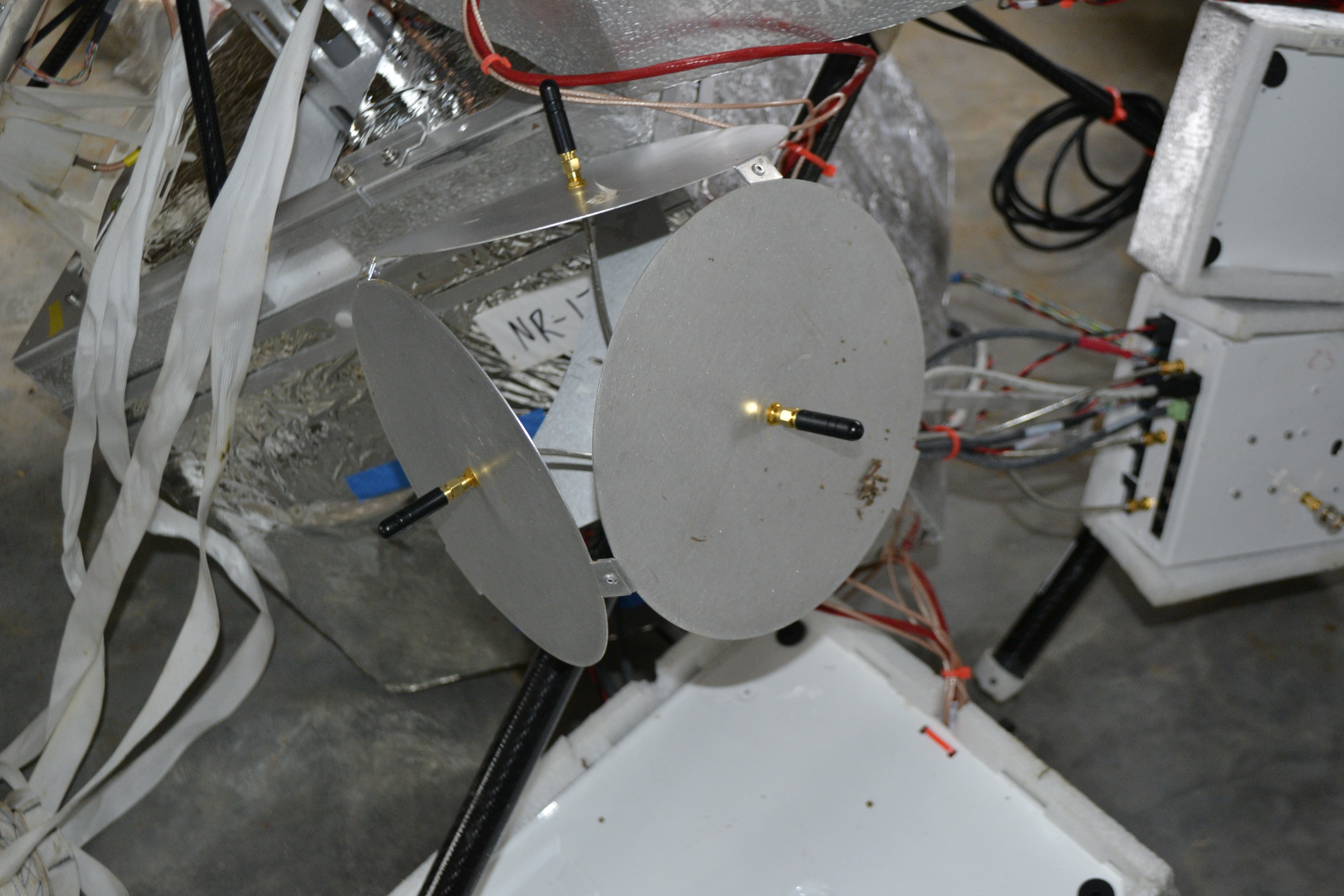
Components of the Google Loon that landed in Sri Lanka earlier this year. Image courtesy ICTA.
Given our previous history of being the first country in the region to test new technologies in the mobile or internet spaces, many feel that we are once again being used as a testing ground. Well, it is true to an extent. Even though the Loon project is almost three years old, it has only been tested in limited locations. But, if tests go well, Sri Lanka might become the first to provide the entire country with internet coverage from balloons, as well as the second country in the world to give the entire nation LTE coverage, after Vatican City.
So what do we get from the Loon Project? To answer this, we will need to take a look at Sri Lanka’s internet penetration, especially LTE penetration.
Sri Lanka was one of the first countries in the region to test and implement LTE (Long Term Evolution) internet. Currently, Dialog Axiata and Mobitel are the two companies providing mobile LTE (FD-LTE) solutions locally. Giving LTE coverage to the country would mean upgrading the infrastructure of not only the service providers, but also the consumers. According to the latest report by the Central Bank of Sri Lanka, the internet penetration of Sri Lanka is around 20%, as of 2015. The Central Bank cites the Telecom Regulatory Commission of Sri Lanka as the source. We personally expected that number to be more, as an older World Bank report places the number close to 22% in 2013. It is evident that the country has seen rapid adaptation to internet services over the past few years. Either way, the conclusion reached is that only 1/4th of the Sri Lankan population has access to internet so far.
According to more reports, geographically speaking, 90% of the country has 3G coverage, while only 44% of the country has 4G-LTE coverage. Additionally, according to this OpenSignal report, even in LTE covered areas, Sri Lankans are able to access LTE signals only around 40% of the time. In short, these numbers show that there is a huge room for expansion of improved wireless internet services in the country. The Loon-based LTE signals will be able to cover the entire nation with LTE, and attempt to provide more consistent coverage availability.
Another instance where Google Loon will become useful is when the country faces any natural disaster and the ground communication gets cut off. We faced a similar situation back in December 2004, immediately after the tsunami. The benefit of having a high altitude floating telecommunication base station like the Loon means that communication on the ground will not be affected even during disasters. Also, the balloons can be moved around to places in need.
To quote from the latest Central Bank report, the Google Loon powered internet is expected to “lead to the evolution of e-learning solutions, facilitating improved access to education opportunities for underprivileged communities. Further, the project will facilitate the expansion of Information Technology Enabled Services (ITES) such as Business Process Outsourcing (BPO) and Knowledge Process Outsourcing (KPO) around the country.”
Broader Plan: Manufacturing Loons For The Region
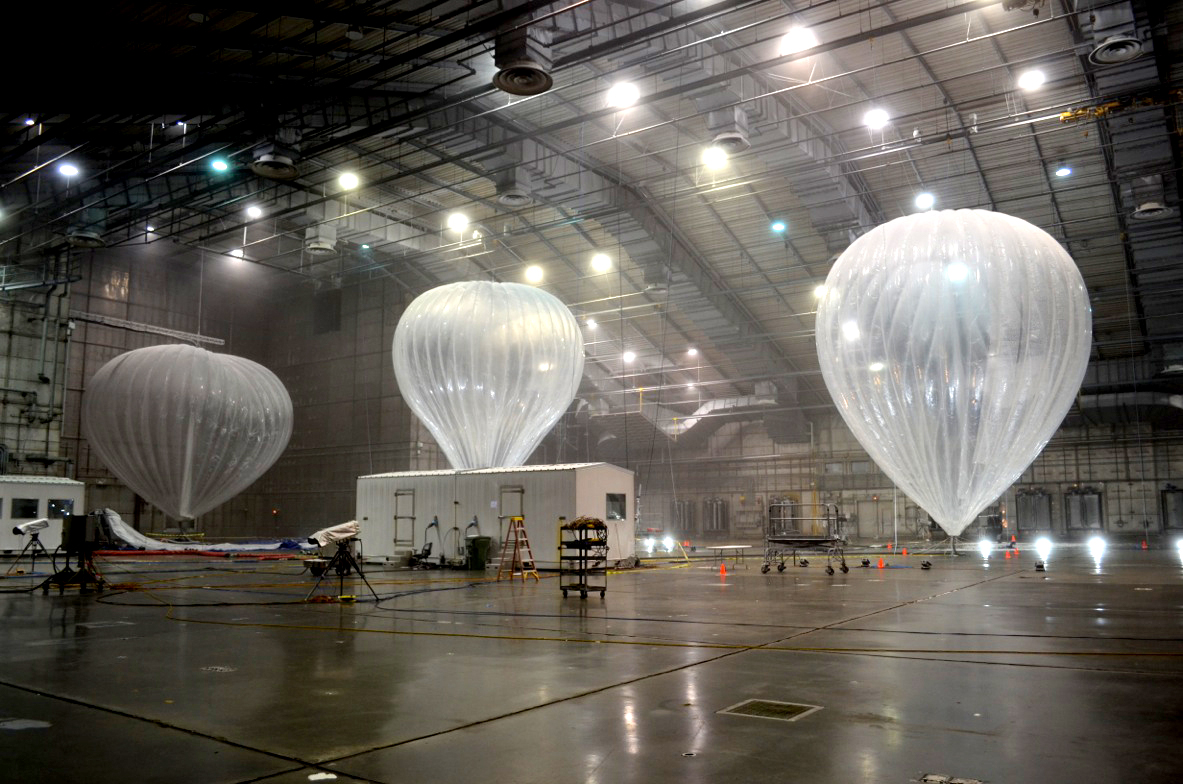
Google Loon balloons being tested in the United States. Image courtesy wired.com/Google
While the primary goal for Google Loon in Sri Lanka is providing affordable internet throughout the country, a chat with the ICTA officials reveals that the Government has a broader plan for the project. Google has already entered an agreement with three telecom service providers in Indonesia to carry out tests in the country. Indonesia is significant since the country is made up of around 17,000 islands and such a geographical nature has always posed a challenge for telecommunication service providers to set up base stations. If tests go well, the Loon project might be able to solve the challenge. Google has also started talks in India to launch Google balloons. India, being a very large country, has a lot of potential to benefit from the project. Such developments in the region have prompted Sri Lanka to show interest in acting as a partner to Google in the project. More specifically, a proposal has been made to Google to set up a manufacturing facility for balloons in Sri Lanka, along with a launching facility. Sri Lanka hopes that this will help Google to expand in the region, while providing the country with additional benefits, in terms of employment opportunities and foreign exchange.
The Challenges

Having internet beamed down to us from above could be a very cost effective move – but the success of this venture depends on several factors. Image courtesy: outerbanks.com
The success of the Google Loon project does not end at balloons flying for months and beaming internet to the land. The actual success will depend on how much Project Loon’s internet helps people to get online, and how much that contributes to improving people’s lifestyles, and the economy of our nation.
We all know that Loon internet won’t be free. But it will definitely be more affordable than the current costs. The benefits for the customers and the telcos will be mutual. But one of the challenges will be to make LTE devices available to consumers, since the balloons will be beaming LTE internet. So far there seems to be no roadmap to address this issue. But ICTA believes that LTE devices (smartphones etc.) are becoming more and more affordable every day, and this will solve the issue. A little market research tells us that the cheapest available LTE enabled smartphone costs around Rs.12,000 in Sri Lanka (whereas a 3G enabled smartphone would cost around half the price, thanks to entry level phones introduced by various manufacturers). That is a positive sign, considering smartphone costs a few years ago. However, there will still be people from certain sectors of society who will hesitate to invest Rs. 12,000 in a smartphone to experience 4G internet, without proper awareness as to how high speed internet can be put to use. Here is where ICTA’s role becomes important ‒ to create more awareness for the public, especially in rural areas, to adapt to newer technologies. This should fall in line with ICTA´s mission to “transform Sri Lanka towards a creative knowledge-based society.”
For a start, the Government could promote LTE enabled smartphones for projects initiated by them. Such future proof planning should begin from now onwards, so the people will be ready to experience LTE services at the time of public launch of Google Loon internet. For example, one of the very latest projects by the national mobile service provider to promote smartphone usage among state sector employees of Sri Lanka, seems to promote only entry level smartphones that do not have LTE connectivity options. We feel that this is an opportunity missed, given that the current workforce of the public sector is more than 1.3 million. But from the service provider’s point of view, they may not see a need to promote LTE devices ‒ at least until they officially partner with the Google Loon project to offer islandwide LTE coverage.
Another question being raised is the cost effectiveness of the Google Loon project, specifically in the long run. Sure, launching the Google Loon balloon up in the air is much cheaper than setting up traditional base stations, but it also should be noted that the balloons have a limited life span. It is said that we would require around 13 balloons to cover the entire country with Loon internet. But the actual number can be less, considering that we do have a part of the country already covered with LTE. The lifespan of a balloon at the time of writing is said to be around 180 days. Google is working to improve that, but this also means that new balloons will have to be launched at regular intervals.
On a related note, Google is not the only entity trying to bring more affordable internet to the masses. Facebook too has an ambitious plan to launch their own solar powered drones called “Aquila”, that will move around the world and create internet hotspots wherever needed. Interestingly enough, the Sri Lankan Government too has already shown interest in the project, even though there seems to be no clear indication whether Facebook will choose to test their drones in our country.
Conclusion
Google’s VP in charge of Project Loon, Mike Cassidy, once quoted a World Bank report based on a study by McKinsey & Co. to point out that “a 10 percent increase in broadband household penetration delivers a boost to a country‘s GDP that ranges from 0.1 percent to 1.4 percent.” The current GDP growth rate stands at around 4.8% in Sri Lanka, according to the Central Bank’s latest report, with around 20% to 25% (mobile + fixed) internet penetration. So it is evident that we have a huge potential to grow, and more affordable internet from Google Loon might just be the boost we require.
Featured image courtesy Project Loon/Google Plus



